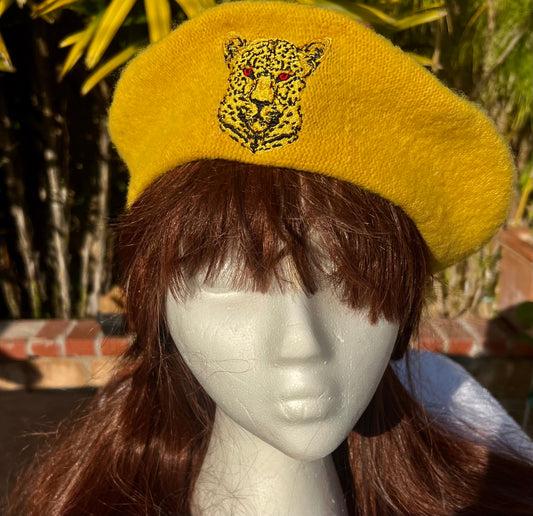Collection: ROYAL FRENCH LEPPARD CREST BERETS!
ROYAL FRENCH BERETS Embroidered LEPPARD CREST on each hat. Crest can be displayed by wearing the crest towards the front, on side or on the back. Join the Leppard Beret Brigade!
History of the Beret
"Think "beret" and an image of a cool-looking French woman who looks like Brigitte Bardot might pop into your head. She's smoking a cigarette and/or eating a baguette. It's raining, and she's wearing a black beret to shield her blonde locks from the slow drizzle.
Think "beret" and an image of guerrilla leader Che Guevara looking sullen while wearing a black beret with a silver star on the front might pop into your head.
Think "beret" and an image of a Black Panther member, their fist high in the air, might pop into your head. Or, similarly, an image of Beyoncé during her Super Bowl halftime show, for which she dressed up her backup dancers as Panthers.
Needless to say, the beret has been around for a while, and has been linked with a plethora of different types of peoples, countries and identities. It's a hat with a powerful, unlikely history.
The ancient era: The first berets were just a cheap thrill.
The silhouette of the beret we know of today — a disk of wool that snuggly hugs the wearer's head — has been around for thousands of years. Archaeologists found traces of hats similar to the beret inside Bronze Age (3200-600 B.C.) tombs in Italy and Denmark, as well as depicted in sculptures and paintings across Western Europe.
Where you now see it most, in varying silhouettes, is from art from this era, worn by artists like Rembrandt in self-portraits and seen in artwork from Johannes Vermeer and Europes low countries depicting peasant life. It was one of the most utilitarian items a person who would be working outside (as many landscape artists did) could wear, so they did. Simple as that.
The 1500 and 1600s: The flat, felt hat becomes a favorite of the poorest classes.
Blame it on how cheap felt was to manufacture, but by the 14th and 15th centuries, berets (which were not yet known as berets, but simply felt hats) had effectively permeated Europe's farming and artist classes
The 1700s and 1800s: The beret gets its name — and gets political.
But then, the 1800s happened. The beret as a political statement first appeared in Spain during the Second Carlist War when Tomas Zumalacarregui, a leader of the Carlists appeared wearing a beginning a long line of revolutionaries and militarized persons donning the flat hat.
The word "beret," which is originally French in origin, was documented first in 1835. It originates from the Latin word "birretum," and the term "bearnais berret" refers to a flat, woolen cap worn by local peasants. During this time over in France, as opposed to in Spain, the blue beret became a symbol for mountain warfare, with the French Chasseurs Alpins, who wore light blue berets to signify their status as elite members of the French Army.
The early 1900s: At last, the black beret becomes a fashion statement for women.
There's no one answer for why a hat associated mostly with the peasant class became a fashion statement. There is only just this: The black beret looks chic as hell. And at the turn of the century in France, this was realized at last, with both men and women turning the hat into a metropolitan staple.
In the streets of Paris through the 1920s on, artists and poets, singers, writers and movie stars, from Ernest Hemingway, French singer Edith Piaf, French actress Arletty and Lauren Bacall were seen wearing the felt cap, which signaled a type of bohemian chicness to passersby.
The 1940s and '50s: World War II turns berets into a wartime staple.
And maybe it was that universal appeal, which spread from country to country in Europe and then to America that made the military take notice.
The round, flat, floppy hat that could be utilitarian in its construction and stylish in its versatility started to become military staple in this era.
Previously, Britain's Royal Tank Corps had adopted black berets during World War I, both for their utility and their ability to hide oil stains. So, by the 1950s, the beret as a military garment had already started to spread, with the U.S. Army's Special Forces adopting green berets, which was a fashion statement so remarkable that the group of men was soon known as "the Green Berets."
From then on, berets would only spread further to different military branches and groups throughout the world, from China, Sri Lanka, Canada and Ukraine.
The 1960s: The beret becomes the political revolutionary's favorite headpiece.
With a renewed interest in the 1960s with new wave French Films came the revival of the beret as a fashion item. Bridgitte Bardot and Catherine Deneuve were seen wearing little black caps on red carpets and to the Cannes Film Festival, as were men like Dizzy Gillespie and Pablo Picasso, but the beret also had a larger significance politically at this time.
It was a signature of men like Che Guevara and Fidel Castro, two of Cuba's most influential political revolutionaries.both wore black berets as they gave speeches and rallied for supporters to rise against the Batista government in Cuba.
The 1970s: The beret becomes a revolutionary symbol.
Although Guevara died in 1967, political leaders' interest in the beret didn't die quite yet. The 1970s (and the late 1960s, for that matter) saw the beret being worn by activist groups across the world, including, most famously, members of theBlack Panther Party
1990s: The beret collides with fashion — and political controversy.
After the Black Panthers made the black beret all their own, who would have thought that it'd find itself on Monica Lewinsky's head in a photograph of the young intern meeting then-President Bill Clinton? Along with that blue dress, the black beret became something of a signature for Lewinsky. "It's time to burn the beret and bury the blue dress" in an effort to put her affair with Clinton behind her. While for a short time during the decade, the black beret was signifier for Monica Lewinsky, it also found its way back to fashion runways. Whether it was an ode to Lewinsky or not, the black beret was seen on high fashion runways in Paris, with a number of models in Thierry Mugler's show donning them with slinky red carpet dresses. As with many decades before this, the beret could live on the line between political statement and fashion statement.
2010s: The past is present and the political is fashionable.
And now in the 2010s, those two worlds can collide. Now, the political (past and present) is fashionable. See: Beyoncé's ode to the Black Panthers during the Super Bowl halftime performance in February with black berets or the use of black berets in Chanel's Resort 2017 runway show, which was hosted in Havana, Cuba. Given the location, it very well could have signified a nod to the country's former leader.
We are now in a decade where the political beret and the fashionable beret can live harmoniously, with performers and designers alike looking to the past for a few revolutionary fashion statements.
After thousands of years of existence, the beret has taken on a number of meanings. At first, it was meant to symbolize a peasant's status, and then an artist. In the 19th century, it had the power to symbolize a political belief. In the 20th century, it could be a fashion statement and a hint to one's ideology. By the 1970s, it could be a signal of black pride and by now, the 2010s, it can symbolize pretty much anything, from a political stance to just wanting to innocently wear a beret.
For a hat, it certainly has a lot of power. "
Article written by Rachel Lubitz
Join the Leppard Beret Brigade!
Product USA at RUNWAY RUNAWAY COLLECTION by Lorelei Shellist
-
ROYAL FRENCH BERET EMBROIDERED LEPPARD CREST BUBBLE GUM PINK
Regular price $29.00 USDRegular priceUnit price / per -
ROYAL FRENCH BERET EMBROIDERED LEPPARD CREST in SWEET PINK
Regular price $29.00 USDRegular priceUnit price / per -
ROYAL FRENCH BERET EMBROIDERED LEPPARD CREST in DUSTY ROSE
Regular price $29.00 USDRegular priceUnit price / per -
ROYAL FRENCH BERET EMBROIDERED LEPPARD CREST in TEAL BLUE
Regular price $29.00 USDRegular priceUnit price / per -
ROYAL FRENCH BERET EMBROIDERED LEPPARD CREST BABY BLUE
Regular price $29.00 USDRegular priceUnit price / per -
ROYAL FRENCH BERET EMBROIDERED LEPPARD CREST in Purple
Regular price $29.00 USDRegular priceUnit price / per -
ROYAL FRENCH BERET EMBROIDERED LEPPARD CREST in TANGERINE DREAMS
Regular price $29.00 USDRegular priceUnit price / per -
ROYAL FRENCH BERET EMBROIDERED LEPPARD CREST BLACK
Regular price $29.00 USDRegular priceUnit price / per -
ROYAL FRENCH BERET Embroidered LEPPARD CREST - ARMY GREEN
Regular price $29.00 USDRegular priceUnit price / per -
ROYAL FRENCH BERET EMBROIDERED LEPPARD CREST LIGHT BEIGE
Regular price $29.00 USDRegular priceUnit price / per -
ROYAL FRENCH BERET Embroidered LEPPARD CREST IVORY
Regular price $29.00 USDRegular priceUnit price / per -
ROYAL FRENCH BERET Embroidered LEPPARD CREST. CARAMEL
Regular price $29.00 USDRegular priceUnit price / per -
ROYAL FRENCH BERET Embroidered LEPPARD CREST KHAKI
Regular price $29.00 USDRegular priceUnit price / per -
ROYAL FRENCH BERET EMBROIDERED LEPPARD CREST NEON GREEN
Regular price $29.00 USDRegular priceUnit price / per -
ROYAL FRENCH BERET EMBROIDERED LEPPARD CREST in PLUM
Regular price $29.00 USDRegular priceUnit price / per -
ROYAL FRENCH BERET EMBROIDERED LEPPARD CREST BROWNY
Regular price $29.00 USDRegular priceUnit price / per -
ROYAL FRENCH BERET EMBROIDERED LEPPARD CREST PINOT NOIR
Regular price $29.00 USDRegular priceUnit price / per -
ROYAL FRENCH BERET EMBROIDERED LEPPARD CREST in FIRE RED
Regular price $29.00 USDRegular priceUnit price / per -
 Sold out
Sold outROYAL FRENCH BERET MELLOW YELLOW
Regular price $29.00 USDRegular priceUnit price / per -
Runway RunAway A Backstage Pass To Fashion, Romance, & Rock 'n Roll
Regular price $15.00 USDRegular priceUnit price / per




















